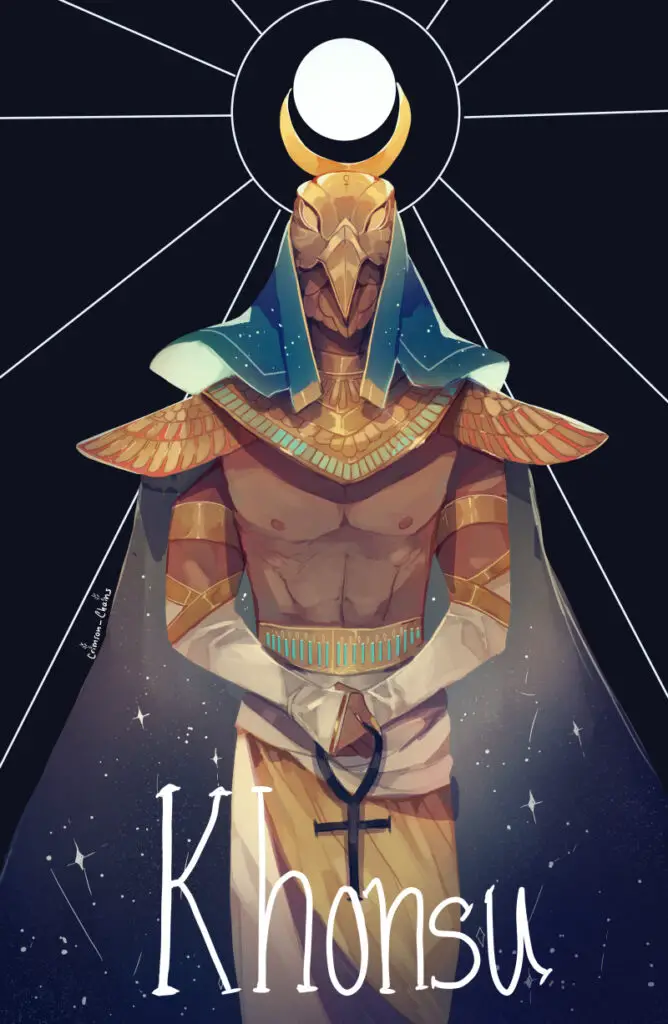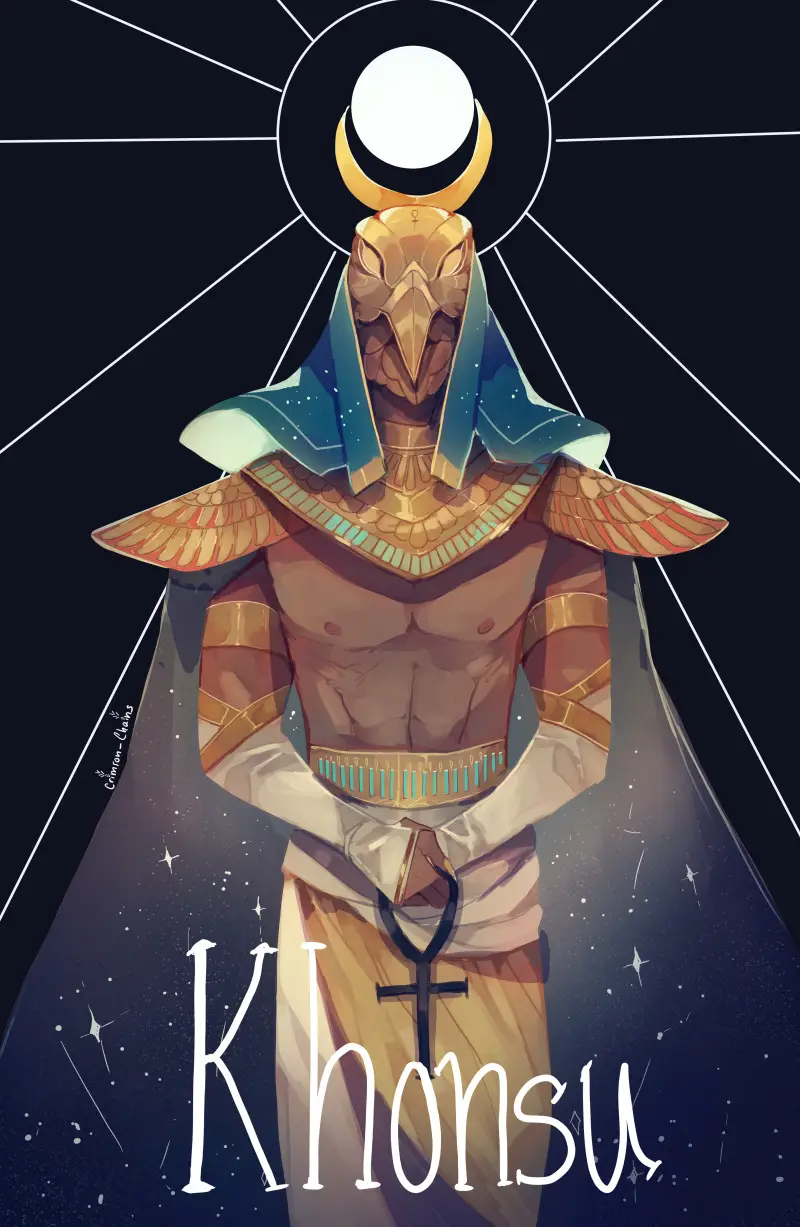
In the rich tapestry of ancient Egyptian mythology, Khonsu shines as brightly as a radiant moonbeam.
He is celebrated as the revered Moon God, and as we set forth on this enthralling journey into the realm of Khonsu, our purpose is clear: to unravel the layers of his identity, to reveal the unique attributes that define him, and to immerse ourselves in the captivating myths and legends that cloak his divine essence.
Together, let us embark on this exploration of the enigma that surrounds the lunar deity, gaining a profound understanding of his indelible significance within the intricate fabric of Egyptian mythology.
Who is Khonsu?
Khonsu, a prominent figure in ancient Egyptian mythology, is revered as the god of the moon, time, and youth.
Depicted as a youthful deity with a sidelock of hair, he holds a crook and flail, symbolizing his protective and nurturing qualities.
Khonsu’s association with the moon represents the cyclical nature of time, and his portrayal as a youthful god signifies everlasting youth and vitality.
He is a symbol of hope and rejuvenation in Egyptian mythology.
- Read also: Who is Anubis in Egyptian Mythology
- Read also: Who were The Mamluks? Unraveling the Incredible Story of Mamluks
Khonsu’s Attributes and Symbols
The Moon
At the heart of Khonsu’s divine domain lies his primary association with the moon.
In the intricate tapestry of Egyptian cosmology, the moon occupied a position of paramount importance.
It was not merely a celestial body; it was a symbol of profound significance, and Khonsu was revered as the deity who held sway over its luminous phases.
His influence extended beyond the earthly realm, reaching into the very fabric of the night sky, where the moon’s cyclical journey served as a metaphor for the relentless passage of time.
Time
Khonsu’s divine mantle encompassed time itself, making him an intrinsic part of the intricate measurement of time and the lunar calendar.
In the grand cosmic ballet, he played a pivotal role in ensuring the delicate harmony and unerring regularity of the cosmos.
As the guardian of temporal order, Khonsu’s presence reassured the ancient Egyptians that the celestial and earthly realms were intricately connected, with the moon’s phases serving as a celestial clock, guiding their lives and rituals.
Youth and fertility
Khonsu’s divine influence extended to the realms of youth and fertility, making him a sought-after deity for blessings in these essential aspects of life.
In the sacred rituals of ancient Egypt, Khonsu’s presence was often invoked during childbirth and healing ceremonies.
Expectant mothers and those in need of rejuvenation turned to him, believing that his divine grace could bestow the gift of youthfulness and ensure the safe arrival of new life into the world.
His association with these themes reinforced his role as a beacon of hope and vitality in the tapestry of Egyptian belief, where the cycles of life and renewal were deeply intertwined.
Protection
Beyond his roles as the god of the moon, time, youth, and fertility, Khonsu was also venerated as a protective deity, particularly during the mysterious veil of nighttime.
In the shadows of the nocturnal hours, people turned to Khonsu as their guardian against malevolent spirits and the unseen perils that lurked in the darkness.
He was seen as a sentinel of the night, a divine protector who shielded his devotees from harm and guided them safely through the obscurity of the evening.
Myths and Legends about Khonsu
The myths and legends surrounding Khonsu are as captivating as the moonlit night itself. Here are some of the notable tales:
Khonsu and the healing of King Ramesses II
Among the illustrious tales that surround Khonsu, one particularly famous legend recounts his pivotal role in the healing of the revered King Ramesses II.
In this captivating narrative, the deity’s divine grace was invoked to cure the ailing pharaoh, underscoring his esteemed position as a god of healing and rejuvenation.
This episode not only showcases Khonsu’s profound influence on the lives of Egypt’s monarchs but also solidifies his status as a benevolent force in the realm of ancient Egyptian mythology.
The lunar calendar
Khonsu’s sacred connection with time bore fruit in the form of the lunar calendar.
His inherent role in measuring time and orchestrating the celestial ballet of lunar phases contributed significantly to the development of this intricate calendar system.
With precision and purpose, the lunar calendar served as a reliable guide for the agricultural cycles and the timing of religious festivals, illustrating Khonsu’s enduring impact on the practical aspects of daily life in ancient Egypt.
The creation myth
Among the myriad myths that enshroud Khonsu, some narratives intertwine him with the very creation of the world.
In these tales, Khonsu is revered as one of the deities instrumental in shaping the cosmos itself.
Such myths underline his paramount importance within the vast tapestry of Egyptian cosmology, portraying him as a celestial architect who played a pivotal role in bringing the world into existence.
- Read also: Tomb Robbing in Ancient Egypt
- Read also: Unraveling the Mysteries of Ancient Egyptian Tombs
Conclusion
In the intricate tapestry of Egyptian mythology, Khonsu emerges as a symbol of profound significance, embodying the mysteries of the moon and the ever-flowing river of time.
Revered as the god who holds sway over the moon, youth, and protection, Khonsu’s influence stretched far beyond the realm of mere myth, leaving an indelible imprint on the daily lives of ancient Egyptians.
As we embark on a journey to unveil the captivating myths and legends that envelop Khonsu, we gain a deep and abiding appreciation for this celestial deity.
His luminance not only graced the nocturnal sky but also illuminated the spiritual dimensions of ancient Egypt, offering a glimpse into a world where the celestial and earthly intertwined in a tapestry of profound meaning and enduring wisdom.
FAQs
Khonsu was worshipped through rituals, offerings, and festivals. Temples dedicated to him, such as the Temple of Khonsu at Karnak, were centers of veneration and worship.
The crook and flail were symbols of authority and protection in ancient Egypt. Khonsu’s possession of these symbols signified his role as a protective and nurturing deity.
While ancient Egyptian religion is no longer widely practiced, Khonsu’s symbolism and influence can still be found in various forms within modern Egypt, particularly in cultural and artistic expressions.



